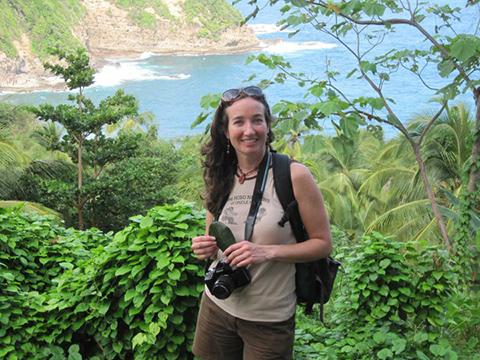Stelacio Shines, Whether Digging Fire Lines or Fighting Ferocious Plants

By PURNELL T. CROPPER
“We had no trees on our street until my mom petitioned the city—she got all our neighbors to sign a letter—and we finally had some planted on our block,” says Maria Stelacio ’11 with a laugh, reflecting on her childhood in Philadelphia and moments that inspired her love of the outdoors.
Before studying conservation at Arcadia, whose name recalls idyllic images of nature, Stelacio led a varied life, traveling west to live in the desert after earning an associate’s degree, and later leaving a corporate job to realize her dream of becoming a park ranger. Now the Newcombe Scholarship recipient recipient practically lives in Boyer Hall, which it turns out she doesn’t mind. In her return to the classroom, the Biology major uncovered something unanticipated and new: a zest for research.
After graduating from the Community College of Philadelphia, Stelacio spent a summer in the Grand Canyon working in the South Rim Village. “I had been thinking of moving to the desert for a while, so when the opportunity arose I took it,” she says. There, she began to seriously consider a career as a park ranger. She envisioned herself preserving America’s most beautiful open spaces and sharing her knowledge of the land. But it was not to be—not yet at least. “I went to the National Park Service to inquire, and they sort of scoffed at me.”
Initial disappointment did not diminish Stelacio’s hopes, though. A few years later, she returned west, settling down in Colorado, where she could hike to her heart’s content. Eventually, she left her job as an auditor at a large retailer to continue pursuing her dream. She became a seasonal park ranger with Jefferson County Open Space after volunteering with the organization and taking additional classes.
In season, Stelacio spent her days directing people along nature trails, discussing flora and fauna, tending to medical emergencies, writing tickets (which she admittedly didn’t like to do), and occasionally putting out brush fires. “We were trained for everything,” she says. “We were sort of a cross between a teacher, police officer and a firefighter.”
During the off season, she coordinated environmental education programs for the Colorado Division of Wild Life, which helped teachers to incorporate material about the environment into their lesson plans.
A New Passion
At Arcadia, Stelacio continues to amass rich experiences in the classroom and beyond, working in the field with faculty and traveling internationally on the way to a B.A. in Biology. During her most recent excursion, a nine-day trip to the Caribbean island of Dominica, a place known for its natural splendor and adventure tourism, she got an up-close look at the intersection of economics and environmentalism. However, Stelacio’s most important discovery has been about herself. “I decided to come back to school originally so that I could become a full-time park Ranger,” she says. “But in the process I fell in love with research.”
An amateur photographer, Stelacio has countless rolls of film depicting plants and landscapes. Her research on invasive plant species allows her to visualize relationships in the natural world in new ways. “[Invasive plants] are very difficult and costly to control and remove,” she explains. “They alter the ecosystem by outcompeting other plants, therefore leaving less food for herbivores, like deer and insects, to consume.”
Stelacio credits Dr. Christopher Binckley, Assistant Professor of Biology, who teaches Research Methods, with providing guidance and support. “Japanese Knotweed is all over Arcadia’s campus—it’s a highly invasive species. Dr. Binckley urged me to do my senior thesis on it, but I already had a project in the works, so I didn’t go that way. But I did end up writing two papers on the plant, a cost-benefit analysis on removing Japanese Knotweed for natural resource economics—that was with Dr. (Wayne) Morra—and another paper in Research Methods.”
Further Adventures
Stelacio’s coursework is not confined to the classroom. For two weeks, she assisted Dr. Lauren Howard, Professor of Biology, with field research about pitch pine in the mountains of West Virginia. “Every day we hiked to our study sites, measured out data plots, determined the plant species, estimated tree heights, extracted tree core samples, tested the soil and gathered soil specimens. All of the data we gathered was recorded for later analysis,” says Stelacio.
In early January, she traveled to the Caribbean’s best kept secret, Dominica, for a course led by Tom Brinker, Professor of Accounting, and Dr. Wayne Morra, Associate Professor of Economics. After studying Dominica’s history, tax structure and economic development for seven weeks in Glenside, Stelacio and her classmates traveled to the island to see how the social, political and economic forces they read about manifested in real life. “As long as regulations are implemented and enforced, then I’ll think they’ll be all right,” she says, analyzing the island’s adventure tourism. “But there are a lot of things that could be done that would destroy the environment.” (View photos from the trip.)
After she graduates in May, Stelacio plans to work as a naturalist or park ranger while deciding on a graduate school. “My ultimate goal is to conduct research on prevention, control and eradication of invasive plant species,” she says. “Not everyone understands the biological reasons for species protection, but everyone can relate to the monetary benefits.”


